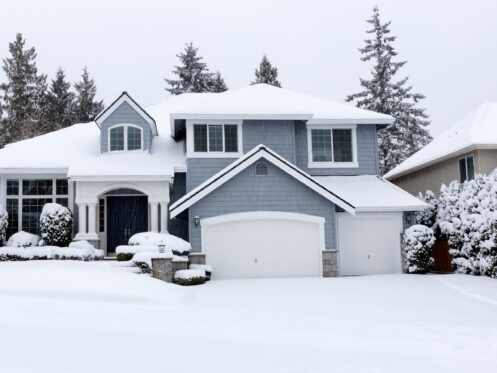As winter arrives, freezing temperatures, snow, and ice can take a toll on your garage door’s performance, leading to sudden breakdowns or frustrating delays. Whether it’s struggling to lift on those chilly mornings or producing odd sounds, the cold weather can put extra stress on your door, making it harder to rely on when you need it most.
Lubrication for Smooth Operation
One of the most important things you can do to keep your garage door running smoothly in the winter is to make sure all its moving parts are well-oiled. Cold temperatures can cause metal components, like rollers, springs, and hinges, to stiffen and become less efficient. Over time, this can strain the motor and cause unnecessary wear. Proper lubrication helps keep everything running smoothly and minimizes the chances of sudden breakdowns.
Before the cold weather hits, take some time to inspect all moving parts and apply a high-quality lubricant. Avoid using WD-40 or other penetrating oils, as they can strip away essential greases and cause more harm in the long run. Instead, choose a silicone-based or lithium grease lubricant designed for garage doors. Apply it generously to the springs, rollers, tracks, and hinges. To keep dirt and grime from sticking to the parts, make sure to wipe off any extra oil.
Lubricating your garage door system helps prevent freezing, squeaking, and sticking and can also extend the lifespan of the components. During the winter, it’s best to perform this maintenance task every couple of months to keep the moving parts free of friction and working smoothly.
Seal Gaps To Protect Against Cold
Another essential aspect of winter garage door maintenance is sealing. Gaps around the sides of your garage door can let in cold air, water, and even bugs, leading to problems such as higher heating bills, rust, and mold. Ensuring that your door is sealed correctly is one of the simplest yet most effective ways to protect your garage and keep it working properly.
First, look at the weatherstripping that’s around the door’s bottom. The rubber seal at the door’s base keeps out cold air and water. This seal may chip, crack, or wear out over time, making it less effective. If the weatherstripping is broken, it needs to be changed. A new seal is relatively inexpensive and easy to install, and it can help keep your garage warmer and more energy-efficient during the winter months.
Next, inspect the seals around the sides and top of the door. These seals should also be in good condition, with no visible cracks or gaps. Even the most minor gaps can allow moisture to seep into your garage, which can freeze and cause issues like ice buildup or frozen door mechanisms. If you find any damage or gaps, replace the seals immediately to prevent cold air from getting in. Good sealing keeps cold air and wetness out and prevents dirt and other things from building up on your garage door tracks, making it difficult for the door to move.
Prevent Freeze-Related Issues
When temperatures dip below freezing, water can accumulate in areas like the door tracks, forming ice. When the ice gets thick enough, it can make it impossible for the door to open or close properly. This can be very annoying if you need to get your car out of the garage in the morning.
Keep the tracks dry and free of waste so that ice doesn’t form in them. Especially after a storm or snowfall, clean the tracks often to keep water and dirt from building up. The track must always be clean and dry for your garage door to work right. Trying to use them when they’re blocked can cause issues requiring garage door off track repair, as the rollers end up moving outside the tracks and put your door off-kilter.
If you get a lot of snow, you might want to add a track heater. Track heaters keep the garage door tracks warm so that ice doesn’t form and the door opens and closes easily. You can use a garage door de-icer if you can’t install a track heater. These items are meant to be applied to the door tracks and other parts to help prevent ice from forming.
If you find that ice has already accumulated in the tracks, it’s essential to handle the situation carefully. Avoid using a hammer or forcing the door open, as this could cause damage. You could use a fan or heat gun to melt the ice slowly or pour warm (not hot) water over the tracks to break up the ice. Once the ice is gone, grease the tracks to keep them from freezing again.
Garage Door Insulation
You can keep the temperature inside your garage fixed by insulating your garage door. This can also help your home’s heating system work better overall. An insulated garage door keeps heat in and cold air out. This is especially important if your garage is connected to your house or if you spend a lot of time in the garage during the winter.
There are several options for insulating your garage door. Many modern garage doors come with built-in insulation. If you have an older door, you can purchase an insulation kit specifically designed for garage doors, which typically includes foam panels or reflective insulation that can be applied directly to the door’s surface.
Check Your Springs, Rollers, and Cables
Winter weather can also cause strain on the components that help your garage door move up and down, particularly the springs, cables, and rollers. When the temperature drops, the metal components contract, which can make them stiffer and more likely to break or wear out.
Check the springs for damage or signs of wear. A broken spring can leave you with a garage door that’s stuck either open or closed, which is both inconvenient and potentially dangerous.
Next, check the cables. These wires and springs work together to lift the door. If you notice any fraying or wear on the wires, it’s essential to replace them before they snap, which could cause the door to fall. Since the cables are under a lot of tension, it’s best to leave the job to a professional.
Finally, inspect the rollers. These small wheels allow your door to slide smoothly along the tracks. Over time, the rollers can become worn or damaged, especially if they’ve been exposed to harsh winter conditions. Make sure the rollers are functioning correctly and replace any that are broken or worn out.
Call Us for Your Garage Door
Winter can be harsh on your garage door, but with the proper maintenance, you can avoid unnecessary hassles and keep things running smoothly. Taking care of your garage door with regular maintenance doesn’t just help you avoid surprise breakdowns—it can add years to its lifespan, saving you both time and money down the road.
At Above the Rest Garage Door Repair, we offer emergency garage door repair, garage door cable replacement, garage door opener repair, garage door off-track repair, garage door spring replacement, and garage door roller replacement. Call Above the Rest Garage Door Repair in Colorado Springs, CO, and we’ll make sure your garage door is in top condition for whatever winter throws its way.





